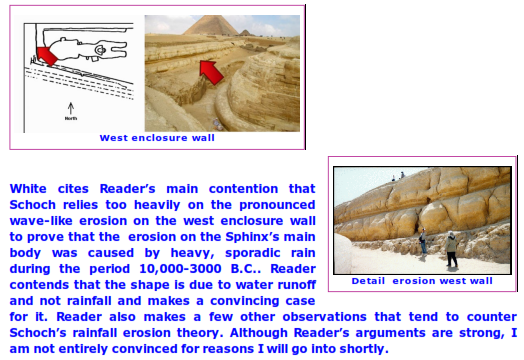3.THE WEATHERING OF THE SPHINX.
This section goes into some detail on the various theories on the weathering we see today on the Sphinx. It is not necessarily easy reading because (1) the various theories are so different and (2) there are some holes in all of them that need filling in, i.e., there are important factors that have been overlooked by all the theorists.
In this section , I'm going to attempt to explain the various theories in the clearest terms I can while also trying to fill in the holes as best I can so that you'll have a better understanding of the strengths and weaknesses of these theories.
I'm also going to use the various theories to show that they buttress my own contention that the Sphinx was constructed over a time span that not only bridged preliterate and literate Egypt, but also bridged the changing climatic conditions between preliterate and ñliterate Egypt.
OK. Let's begin to tackle this weathering beast by starting with the obvious: what our eyes tell us when we look at the Sphinx today.
he late 19th century photograph (Above, L) shows both man-made damage and the effects of weathering since the last (c.300 A.D.) restoration was done approximately 2000 years before in the Roman era. Please note that compared to the body, the head was in pretty good shape after 2000 years.


“….the initial carving of the Great Sphinx (i.e., the carving of the main portion of the body and the front end) may have been carried out c.7000 to 5000 B.C..”
Here is Shoch again on the matter:
"On the body of the Sphinx....I found heavy erosional features .....that I concluded could only have been caused by rainfall and water runoff. The thing is, the Sphinx sits on the edge of the Sahara Desert and the region has been quite arid for the last 5000 years. Furthermore, various structures securely dated to the Old Kingdom show only erosion that was caused by wind and sand (very distinct from the water erosion). To make a long story short, I came to the conclusion that the oldest portions of the Great Sphinx, what I refer to as the core-body, must date back to an earlier period (at least 5000 B.C., and maybe as early as 7000 or 9000 B.C.), a time when the climate was very different and included more rain." I invite you to read more of Shoch on his SITE as well as his latest very detailed rebuttal of his critics.


Here is the timetable I am going to propose. It also indicates which of the literate, Dynastic Pharaohs I believe could have done the body carving. The phases are not arbitrary from an artistic point of view, especially one that is sympathetic to the-Proto Egyptian and Dynastic Egyptian aesthetic that would have seen the carving as one long continuous birth.
Phase 1. bas relief face 6000 B.C.
Phase 2. face back to ears 5800 BC.
Phase 3. front chest and limbs, head to just behind ears, veil 5600B.C.
Phase 4. Nemes, back of head (Djoser c.2660 3rd Dynasty).
Phase 5. Front body to 30 feet behind of head. (Sneferu c. 2590 B.C. / 4th Dynasty)
Phase 6. Back body up to rump, back limbs, paws. (Djedefra c. 2560 B.C. / 4th Dynasty)
Phase 7. tail 2550 B.C. Kafre
OK. Here's my thinking on the factors that various geologists cite as the cause of the erosion we see on the Sphinx, as well as what that erosion means in terms of determining the creation date of the Sphinx.
Let me say right at the start that it seems to me that all the existing alternative theories have major flaws in them. They all point toward a much earlier construction date than the establishment date of c.2500 B.C., but until further investigation is done, the question of how far back can’t really be answered.
Part of the problem is that both the establishment and the various alternative views assume that the Sphinx was built in one fell swoop. For those theories (establishment, Colin Reader) that favor construction after 3200 B.C., carving it in one fell swoop would be the most likely case, as that is the way of a literate culture.
However, several factors argue against the probability that the Sphinx was constructed in literate times. I have gone into many of them earlier and while I am sure that many dismissed my arguments out of hand as preposterous, they are not so easily dismissed if they are closely examined responded to in a logical, responsible manner. That would require, of course, that the responders have some knowledge of preliterate cultures, which unfortunately is almost completely lacking, so dismissal is an easy way out.
Author's Note
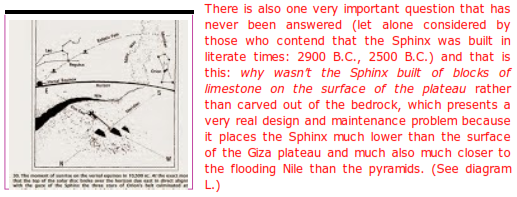
For sure, the Egyptians c . 2500 B.C. would have immediately realized that carving the Sphinx in the manner we see it today would lead to it being buried by sand as well as create a serious flaw in the overall harmony of the Giza site. In other words, there would be no reason to construct the Sphinx as we see it today when they were capable of sophisticated block construction. After all they built the pyramids.
Here’s the basic quest ion: if the Dynastic Egyptians had enough smarts to posit ion the Giza pyramids to mirror the Orion constellation, surely they had enough smarts to realize ( among other things) that the Sphinx would be buried by sand almost as soon as it was carved.
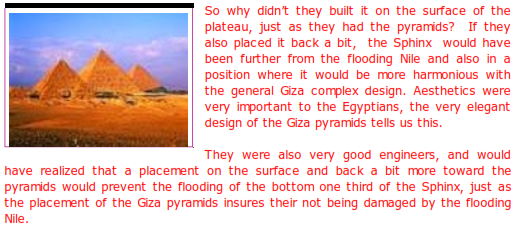
The bottom one third of the Sphinx, by the way, has been the subject of every restoration we know of, which may have started (according to Schoch) as early as the Old Kingdom in the time of Kafre (thereby proving the Sphinx was carved at a much earlier date).
Here is an excerpt from Schoch's site on the Age of the Sphinx discussing this claim in greater detail:
"The body of the Sphinx has been subjected to various repair campaigns, beginning with the ancient Egyptians themselves and continuing up to the present day. The earliest repairs to the body of the Sphinx have been carried out using what appear to be Old Kingdom style masonry techniques. Gauri and his colleagues (see for instance Punuru et al., 1990, p. 230) consistently refer to these in such terms as "Pharaonic veneer stones" that have experienced "5,000 yr of exposure to local conditions," that is, they were applied during Old Kingdom times.
Likewise, Hawass (1992, p. 14) states that: "It seems that the Sphinx underwent restoration during the Old Kingdom because the analysis of samples found on the right rear leg proved to be of Old Kingdom date." If the oldest repairs to the eroded body of the Sphinx do date to Old Kingdom times, this is another strong argument in favor of a much earlier date for the Sphinx.
Lehner has analyzed the repair campaigns to the Sphinx (see Lehner, 1980; Hamblin, 1986), concluding that, despite his own evidence to the contrary, "To seek agreement with known historical facts [i.e., his contention, among other things, that the Sphinx was built in circa 2500 B.C. by Khafre], we should probably expect the earliest restoration to have been done in the New Kingdom [circa 1500-1400 B.C.]" (Lehner, 1980, p. 18). In summary, in order to save the attribution of the Sphinx to Khafre (Chephren), circa 2500 B.C., Lehner suggests that the earliest level of "large-block" (Old Kingdom style?) masonry was added to the Sphinx during the New Kingdom.
Taking not only Lehner's work into account, but also the evidence for the twostage construction of the Sphinx and Valley Temples (discussed above), the research that has been carried out concerning different modes of weathering on the Giza Plateau (discussed above), and the seismic surveys in the area of the Sphinx which give data on the subsurface depth and distribution of weathering around the Sphinx (discussed below), and considering the fact that the attribution of the Sphinx to Khafre is based on circumstantial evidence to begin with (see Schoch with McNally, 1999, 2000), I find one conclusion inescapable -- the initial construction (carving) of the core body of the Sphinx predated the time of Khafre. Lehner's own work is more easily reconciled with the hypothesis that the Fourth Dynasty Egyptians merely restored, refurbished, and added to the Sphinx and its associated structures, rather than being the original creators of the Sphinx complex."
One thing we know for sure is that there is clear documentation Thut mose undertook a massive restoration of the Sphinx around 1400 B.B..
This restoration plus the undocumented but very probable restoration that Schoch says took place in the time of the Old Kingdom and Kafre (2658 B.C.) indicates to me not only that the Sphinx is much older than 2500 B.C., but also that flooding must have played an essential role in its significant erosion despite the fact that the bot tom one third is made of a much harder limestone than the upper 2/3 of the body.
End Author's Note
OK, so much for the obvious, which seems to be something our theorists never consider.
Let's take a look now at Colin Reader's proposed date of 2900 B.C. for the construction of the Sphinx.
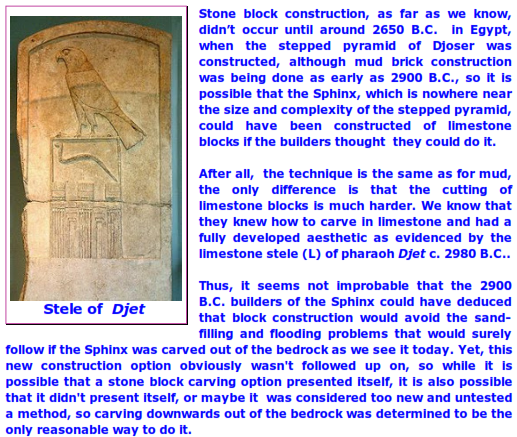
But there is an equally important question that remains to be answered: why was the monumental Sphinx carved in 2900 B.C., i.e., what, or who, did the Sphinx honor? Reader gives no answer to this. In addition, Reader like Schoch, proposes that the head was originally carved as a lion, but why and by who? Reader gives no answer to this either. There is also this fact for which neither Reader or Schoch have an answer: no monumental statue of an animal has ever been found anywhere, let alone Egypt. And then there are the definite preliterate characteristics of the face that have to be explained, something I’ve gone into in great detail earlier.
By the way, what I have just pointed out represents a different type of approach to analyzing Reader’s theory of a 2900 B.C. Sphinx carving, but it strongly suggests that Reader’s numbers may be quite off and that a much longer period of sand burial may have been necessary to create the damage we see on the core body and that it may stretch back deep into preliterate Egypt.
What seems clear to me from all this, and from my previous arguments about the preliterate characteristics of the face, is that the face of the Sphinx was carved in preliterate times and it was carved in the artistic manner it was because that is exactly the manner in which preliterate peoples would have done it. I have given the reasons why I believe it was done—to honor a Nubian shaman/leader as a living Goddess, but I want to say more about what I mean by saying that the Sphinx was carved in exactly the manner in which preliterate peoples would have done it.
First of all, the preliterate the Proto-Egyptians had very limited tools and techniques for stone carving. They knew nothing about block carving, only carving out of existing stone. I have a site in which I point out that the Parthenon and the later stages of Stonehenge with its huge sarcens are only 800 years apart, and that one of things that explains why Stonehenge doesn’t exhibit the sophisticated carving of the Parthenon is that the Greeks had enjoyed 500 years of literacy with its ability to record and demonstrate and debate architectural techniques. Those 500 years of literacy allowed the Greeks to progress from stone structures like Stonehenge to the Parthenon. The preliterate Stonehenge builders had no such advantage.
For the Proto-Egyptians who carved the Sphinx face, stone carving would have been hard work (stone on stone but not impossible, after all their petroglyphs were carved in this manner)very doable) but also work that had no real precedent. It was made even more daunting because they had no long, literate architectural tradition to guide them. They only had the desire to honor River Mother, and to do that they chose to carve her face on the yardang or outcropping on top of the Giza plateau. I have given my reasons previously why they would have done this, but let me repeat them briefly.
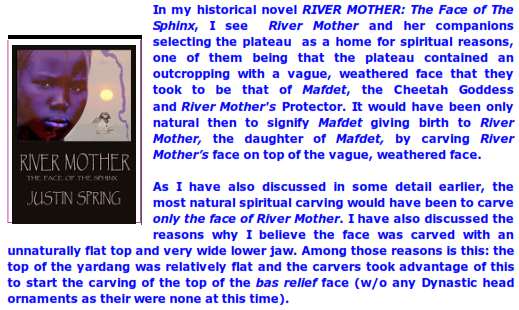
The carvers also took advantage of the shape of the facing surface (which probably contained the vague, weathered face) of the yardang or outcropping. I also believe this facing surface stood out from the entire frontal surface of the yardang because it was slightly curved, as would be only natural. I also believe the facing surface was probably relatively square in shape (the top of the facing surface was as wide as the bottom of the facing surface).
The entire yardang frontal surface was probably slightly wider than the facing surface, and perhaps became even wider as you proceeded back from the facing surface, but the facing surface would have presented a smaller but square-proportioned surface for the bas relief face carving. Thus taking advantage of the shape of the facing surface meant they would have to carve less rock away to form the bas relief face.
There were other reasons for the face being shaped the way it is, something I've gone into in great detail earlier, but we shouldn’t ignore the fact that honoring the squarish shape of the facing surface may have also meant that they would also be in harmony with the other more spiritual reasons for carving a squarish face that I have mentioned earlier, e.g., the flat top and wide lower jaw are characteristics of the cheetah’s frontal face.
The way I see the carving progressing is this: after the face had been carved out of the facing surface of the yardang, the carving would have been considered spiritually complete. Eventually, however, other spiritual visions would have presented themselves indicating that the time had come to flesh out the front of the head back to the ears, the chest and front limbs ( Phases 1-3). The only recourse would have been to carve those out of the rock around the bas relief face and below it. That would have been the preliterate way.
Since the carving the chest and front limbs would have meant carving away a great deal of stone, it would have been a big task, but not impossible by any means, especially if we posit that the most important thing for the ProtoEgyptians to carve would have been the passageway to the face created between the two front limbs.

I see this need for a passageway to view the face as the spiritual reason that brought about this phase of the carving
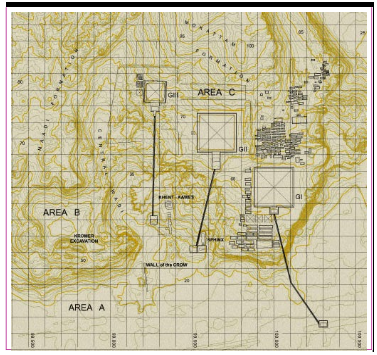
What I am suggesting by saying this is that the chest may not have been carved in a finished sense at all, but just enough rock removed to carve the two front limbs, so that the limbs would have appeared out of the rock just as the face appeared out of the rock high above. In addition the free space on the outside of the front limbs would most probably have either been non-existent, or only slightly suggested or very, very much less than the free space we see in the enclosure today. All this could have been done later in Dynastic times, when the aesthetic demanded a realistic, fully carved animal body. Preliterate cultures had no such aesthetic.
One thing that is immediately evident is that such a staged carving would not have created the closed sub-surface enclosure we see today into which sand would immediately rush and be trapped. The only part that would have been subject to burial under sand would have been the limbs (which seem to have been the subject of a great deal of erosion if the subsequent restorations are any measure.)
It is also very likely that there was no front barrier at the Nile end to trap sand. I say this because given the gentle slope of the plateau (see the topographical map above showing the slope of the plateau) most of the sand that fell in around and between the limbs would have flowed down toward the Nile aided by the slope and the sporadic heavy rains.
If we look at the cross section diagram of the Sphinx above we can see the east-looking front of the enclosure has been artificially created by sand fill (most probably at a later stage when the temples were created) and if we connect the rock portions of the plateau, the downward gentle slope of the plateau is quite evident. It is this slope that would have aided the sand flowing down to the Nile.
This doesn’t mean that the limbs weren’t subject to some degree of sand burial and Nile flooding, because they would have been, but they wouldn’t have been as completely buried as they would have been if the enclosure was as it is today. This is important, because according to Reader, burial under wet sand can cause very rapid deterioration of the limestone, i.e., over hundreds not thousands of years.
If the slope aided in the removal of sand, the damage would be much, much less and would account for the limbs not being completely destroyed over the thousands of years they existed under my timetable for construction of the Sphinx.
Equally possible is that the preliterate hunter/ gatherer tribes aided in clearing the sand between the limbs because the passageway between the limbs was meant to provide a spiritual approach to the face (something often seen in preliterate structures) and would most likely have been kept clear for pilgrims. This may seem improbable but we have to remember that there may have been very little disorder in these Proto-Egyptian hunter/gatherer tribes over thousands of years compared to the kind of disorder caused by the rise and fall of dynasties in literate Egypt. I say this because it seems to be evident from what we know of Göbekli Tepe that its hunter/gatherer culture remained orderly enough to construct and maintain its vast, complicated spiritual monuments over a two thousand year period.
Author's Notes
Let me say a few words about my theory of preliterate staged construction vis a vis Reader’s theory of one fell swoop construction.
If Reader's dating of a 2900 B.C. construction of the Sphinx proves to be in error, and is actually much further back in time, his Sphinx would most probably been constructed in stages somewhat similar to my own suggested stages, because that is the preliterate way.
Similarly, if Schoch’s theory on weathering proves to be correct, i.e., the Sphinx would have been constructed in preliterate times, most likely 7000-5000 B.C.. It is almost certain that it was constructed in stages similar to my own suggested stages.
As far as that old canard that the head was originally that of a lion (that both Shoch and Reader subscribe to being scientists who have never considered the aesthetic and spiritual reasons that would have prevented such carving, or a re-carving), I think I have said enough earlier about the reasons why the lion’s head theory is an aesthetic and spiritual impossibility. I believe we can safely assume that the small head we see is the original face and that it reflects the correct proportions of the cheetah’s head and body.
End Author's Notes
Let me get back now to the theories of erosion currently being bandied about by the establishment (Lehner et al) and the alternative thinkers (Schoch and Reader and myself).
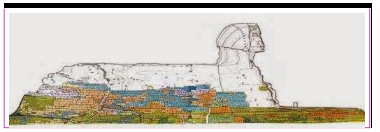
If you want to bring yourself up to date on the repairs that have been made to the Sphinx, TOUREGYPT has be far the most lucid and shortest article on the subject.
I would strongly suggest you read it as it will also give you a clear idea of the complicated erosion factors at play. It contains the diagram above which is a color coded diagram of all repairs to the Sphinx
First let me say there is a very persuasive, but by no means final, summing up by Chris White of the argument between geologists Robert Schoch and Colin Reader on the cause of the erosion we see on the body of the Sphinx.
After reading Reader’s arguments, White, who initially found Schoch’s theory persuasive, comes down in favor of Reader for a number of good reasons, but I am not entirely convinced he is correct on all of them.
